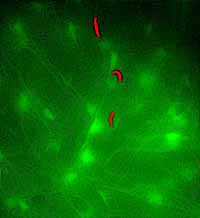
Tagged with red fluorescent protein, the malarial parasites in the sporozoite stage can be seen migrating along the sinusoids in a mouse liver. (Photo: Ute Frevert et al.)Despite the efforts of governments and the World Health Organization to combine prevention measures and efforts to eradicate malaria-carrying mosquitoes, the disease kills more than a million people each year. Much is known about the microbes that cause the disease, tiny parasites of the genus Plasmodium, which have a complex life cycle involving several distinct phases and habitats. But, many details of the organism's life cycle, including a critical stage in the parasite's life cycle – invasion of the liver - have escaped direct observation until now. In their new study published in the open-access journal PLoS Biology, Ute Frevert et al. used intravital microscopy - which allows direct observation of events in a living animal - to study the discrete steps that facilitate the parasites' entry into the liver.
To make these observations, the authors introduced genetically engineered Plasmodium parasites that express fluorescent tags to rodents through mosquito bites, and then watched for the arrival of the parasites in the livers of the test animals. They observed parasites crawling along the interior of the liver sinusoids (which take the place of capillaries in the liver), sometimes against the direction of blood flow, until they reached their portal of entry - a specialized cell called a Kupffer cell. They then watched as sporozoites traversed Kupffer cells using a special process distinct from ordinary parasite locomotion.
Upon exiting the Kupffer cell on the other side, the sporozoites wreaked havoc in the liver, leaving a path of destruction and dead cells behind them. They moved through several consecutive hepatocytes before finally settling down in one to begin reproducing. The visualization advantages provided by using the fluorescent parasites and intravital microscopy now make it possible to directly observe events in the Plasmodium life cycle that had only been inferred before. Understanding the invasion will help researchers in the battle against this deadly disease organism.
Citation: Frevert U, Engelmann S, Zougbede S, Stange J, Ng B, et al. (2005) Intravital observation of Plasmodium berghei sporozoite infection of the liver. PLoS Biol 3(6): e192.
Source : Public Library of Science
 Print Article
Print Article Mail to a Friend
Mail to a Friend
